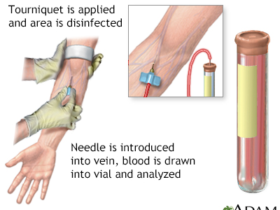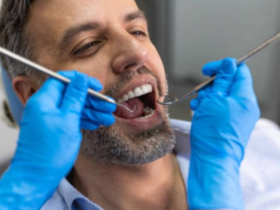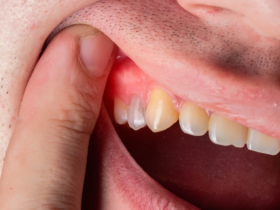Introduction
Epstein pearls are a common and benign condition found in newborns, yet they can often cause concern for unfamiliar new parents. These small, white or yellowish cysts typically appear on the gums and the roof of a baby’s moubaby’ssembling tiny pearls. Named after Alois Epstein, who first described them in the 19th century, these cysts are harmless and usually resolve independently within a few weeks to months. However, understanding Epstein’s pearls’ nature, identification, and appropriate management is crucial for healthcare providers and parents to ensure proper care and reassurance.
What Are Epstein Pearls?
Epstein pearls are tiny, white or yellowish cysts that appear in the mouths of newborns. These cysts are typically found along the midline of the hard palate and on the gums. They are filled with keratin, a protein for skin, hair, and nails. The formation of Epstein pearls is a normal part of the development of the oral cavity. During fetal development, the tissues in the mouth form folds and ridges. Occasionally, these folds can trap keratin-producing cells, leading to the formation of these small cysts.
The prevalence of Epstein pearls is relatively high, with studies indicating that they occur in up to 85% of newborns. They are more common in full-term infants and are less frequently observed in preterm babies. These cysts are not associated with any underlying health conditions or genetic abnormalities. Epstein pearls are a natural part of neonatal development and do not pose any risk to the infant’s health.

Identification of Epstein Pearls
Identifying Epstein’s pearls is relatively straightforward for healthcare professionals. These cysts are small, typically measuring 1-3 millimetres in diameter, and have a pearly white or yellowish appearance. They are usually located on the hard palate, specifically along the midline, and sometimes on the gums. Unlike other oral conditions that may cause discomfort or pain, Epstein pearls are asymptomatic and do not interfere with feeding or breathing.
A paediatrician or a family physician can quickly identify Epstein’s pearls during a routine newborn examination. Parents often notice cysts while feeding or during routine oral hygiene. Healthcare providers must educate parents about these cysts’ benign nature to alleviate any concerns. In rare cases, Epstein pearls can be confused with other conditions, such as Bohn’s nod. Bohn’s dental lamina cysts also present as white or yellowish lesions in the mouth. However, Epstein’s pearls’ location and typical appearance usually make the diagnosis clear.
Differential Diagnosis
While Epstein’s pearls are benign and self-limiting, it is essential to distinguish them from other conditions that may require medical intervention. Bohn’s nodBohn ‘sfor, for instance, are also keratin-filled cysts that appear on the alveolar ridges, but they are less common than Epstein pearls. Dental lamina cysts, another differential diagnosis, occur on the gums and can be mistaken for Epstein pearls. However, these cysts usually appear in different locations and have different aetiology.
Oral thrush, caused by a fungal infection, can sometimes be confused with Epstein pearls. However, thrush typically presents as white patches on the tongue and inner cheeks and can cause discomfort and feeding difficulties. Unlike Epstein pearls, oral thrush requires antifungal treatment. Congenital epulis, a rare benign tumour of the gingiva, can also mimic the appearance of Epstein pearls but is usually larger and may require surgical removal.
Accurate diagnosis by a healthcare professional is essential to ensure that no underlying conditions are overlooked and that appropriate reassurance is provided to the parents.
Management of Epstein Pearls
Due to their benign nature, Epstein’s’s pearls are straightforward to manage. No medical treatment or intervention is necessary, as these cysts typically resolve on their own within a few weeks to months. Parents should be reassured that Epstein’s pearls do not cause discomfort or interfere with the baby’s feeding and breathing.
Healthcare providers should educate parents about the natural history of Epstein’s pearls to prevent unnecessary concerns and interventions. It is crucial to advise parents to maintain good oral hygiene for their newborns and to avoid attempting to remove the cysts themselves. Any attempts to manually remove or puncture the cysts can lead to unnecessary trauma and potential infection.
In cases where parents are particularly anxious or if there are concerns about other oral conditions, a follow-up visit can be scheduled to monitor the resolution of the cysts. However, in most cases, Epstein’s pearls will disappear without intervention.
When to Seek Further Medical Advice
While Epstein’s pearls are benign and self-resolving, there are instances when further medical advice should be sought. If the cysts do not resolve within a few months or there are any signs of infection, such as redness, swelling, or discharge, a healthcare professional should be consulted. Additionally, further evaluation is warranted if the infant experiences difficulty feeding, excessive drooling, or any other symptoms that could indicate an underlying issue.
Parents should also seek medical attention if they notice any unusual growths or lesions in the mouth that do not match the typical appearance of Epstein’s pearls. While rare, other conditions can present similarly and require medical intervention.

Reassurance and Education for Parents
Providing reassurance and education to parents is crucial to managing Epstein’s pearls. Many new parents may be unfamiliar with these cysts and could be alarmed upon discovering them in their baby’s moubaby’sear communication from healthcare providers about the benign nature of Epstein pearls and their typical course can help alleviate concerns.
Healthcare providers should emphasize that Epstein pearls are regular in newborns and do not require treatment. Parents should be advised to maintain standard oral hygiene practices and avoid touching or attempting to remove the cysts. Providing educational materials or resources about Epstein’s pearls can also be helpful for parents seeking additional information.
Conclusion
Epstein pearls are a common and benign condition found in newborns. They are. They are characterized by small, white or yellowish cysts on the gums and roof of the mouth. Understanding Epstein pearls’ nature, identification, and management is essential for healthcare providers and parents to ensure proper care and reassurance. These cysts are harmless and typically resolve independently within a few weeks to months, requiring no medical intervention. Clear communication and education about Epstein’s pearls can help alleviate parental concerns and promote a better understanding of this common neonatal condition.
Also, Read The Following: what is mpv in blood test.
















Got a Questions?
Find us on Socials or Contact us and we’ll get back to you as soon as possible.